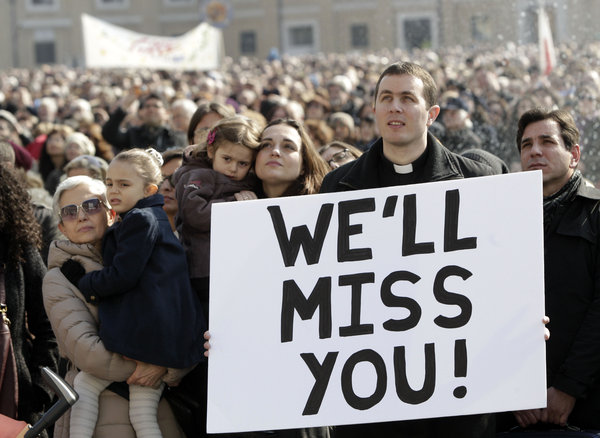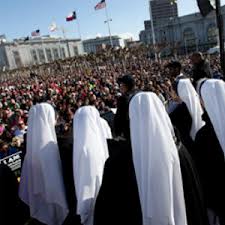Category Archives: News
Priestly Fraternity of St. Peter
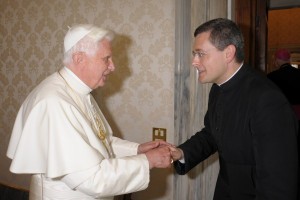
It has been awhile since I looked at the Priestly Fraternity of St. Peter’s website so I was happy to see that they have the largest class of tonsurandi in their history. The term tonsurandi was new to me so I was glad that they provided an explanation. The Rite of Tonsure is administered early in the second year of formation, and is the point at which a seminarian is invested with the cassock and surplice.
The Priestly Fraternity of St. Peter, an IRL Affiliate, was founded in 1988 in Switzerland, though they established their Motherhouse in Wigratzbad, Germany, shortly thereafter. They were blessed in 1990 to have a visit from the then-Cardinal Ratzinger, now Pope Benedict XVI, who celebrated mass in the Traditional rite and has been a good friend to them from their beginnings. I’m sure they will miss his paternal support.
In a statement released after the announcement of Pope Benedict’s abdication the Fraternity said: “We offer our sincere gratitude to the Holy Father for his tireless efforts to guide the barque of St. Peter along the path set out for Her by God. We thank him, in particular, for his kindness and paternal solicitude, especially on behalf of the faithful attached to the Extraordinary Form of the Latin Rite, which he universally restored to its honored place in the Church by his Motu Proprio Summorum Pontificum in 2007.”
The Fraternity seminary in the Unites States, one of two that they operate, is located in Denton, Nebraska, which when it opened in 2000 welcomed 50 seminarians! They have many parishes throughout North America and Europe and Australia as well as missions in Nigeria and Brazil. Today, they have an astounding 397 members (11/2012) according to their website.
We Will Miss Him
A Milestone in North Dakota
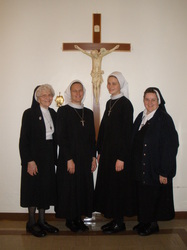 This year, the Sisters of St. Francis of the Immaculate Heart of Mary in Hankinson, North Dakota, are celebrating their 100th anniversary in America. Also known as the Dillingen Franciscans, the sisters arrived in Collegeville, Minnesota, from Germany in the summer of 1913 and served in the community there until 1958. In 1921, they opened a parochial school in North Dakota where the Motherhouse was built and still is today.
This year, the Sisters of St. Francis of the Immaculate Heart of Mary in Hankinson, North Dakota, are celebrating their 100th anniversary in America. Also known as the Dillingen Franciscans, the sisters arrived in Collegeville, Minnesota, from Germany in the summer of 1913 and served in the community there until 1958. In 1921, they opened a parochial school in North Dakota where the Motherhouse was built and still is today.
There are many Franciscan communities around the world , many of them new foundations. The charism of St. Francis of Assisi has remained new and vibrant for lo these many hundreds of years. The Sisters however are one of the very ancient communities for they can trace their beginnings back to 1241 in Germany (just 15 years after the death of St. Francis himself!). In the early 1300’s they became affiliated with the Friars Minor of the Strasburg province and they received the Third Order Rule of St. Francis. To survive almost 800 years in the middle of Europe is incredible.
In 1803, the government confiscated all of their land and buildings. The sisters were allowed to remain in the convent until their deaths but no new postulants were allowed to enter the community. By 1828, there were only 5 sisters left but it was enough for a new beginning. By1847, there were 53 sisters and by 1968 there were over 2300! The Lord uses even the smallest seed to grow a large, fruitful orchard. The sisters today serve in Germany, Brazil, India and the US. In North Dakota they care for the elderly and sick, teach young people, visit the imprisoned, support pro-life causes, run a retreat house, produce altar breads and do other evangelical activities.
Commenting on the German sisters who came to foreign soil in Minnesota, Sr. Ann Marie Friedrichs, OSF, said, “I am filled with an immense amount of joy and pride every time I think of the courage and vision it took for our German sisters to leave their homeland…not familiar with the American customs and totally unable to speak English. What trust in God they had to say ‘yes'”!
The Lost Sheep and the Shepherd
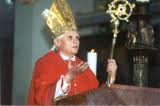 I was thinking about the image of a shepherd’s crook recently and remembered a homily that I heard long ago about the symbolism of the crosier (pastoral staff) as conferred to a bishop when he receives his Episcopal consecration. The priest said that the crook was used by shepherds to draw in wayward sheep that had left the flock. The image that came to mind was a sheep standing on the edge of a precipice with the shepherd drawing him back to safety, maybe unbeknownst to the sheep. The Catholic Encyclopedia says that the episcopal staff is the symbol of that doctrinal and disciplinary power of bishops in virtue of which they may sustain the weak and faltering, confirm the wavering in faith, and lead back the erring ones into the true fold.
I was thinking about the image of a shepherd’s crook recently and remembered a homily that I heard long ago about the symbolism of the crosier (pastoral staff) as conferred to a bishop when he receives his Episcopal consecration. The priest said that the crook was used by shepherds to draw in wayward sheep that had left the flock. The image that came to mind was a sheep standing on the edge of a precipice with the shepherd drawing him back to safety, maybe unbeknownst to the sheep. The Catholic Encyclopedia says that the episcopal staff is the symbol of that doctrinal and disciplinary power of bishops in virtue of which they may sustain the weak and faltering, confirm the wavering in faith, and lead back the erring ones into the true fold.
When I was in the Holy Land driving around the desert in a rental car with a friend and a priest in tow, we passed a gas station in the middle of nowhere that was a popular stop for trucks. The noise and the fumes were tremendous. But in the corner of the gas station parking lot was a shepherd and around him, in a perfect concentric circle, were his sheep. You couldn’t have gotten a piece of tissue paper between them, they were packed in that tightly together .
What struck me was that they couldn’t have been terrorized because then they would have been dashing about in a frenzy. The shepherd must have given them a command and so they formed in around him. They had perfect trust in their shepherd to protect them in what had to be a hostile and unnerving environment.
I thought of that image yesterday when I heard of Pope Benedict’s retirement. My first reaction was one of anxiety— Who would be our shepherd? I realized how much I had come to trust in this shepherd. The Lord said, “And I will set up over them one shepherd, my servant David, and he shall feed them: he shall feed them and be their shepherd” (Ezekiel 34:33).
In the Gospel of Matthew, it says: “When Jesus saw the crowds, He had compassion on them, because they were harassed and helpless, like sheep without a shepherd” (Matthew 9:26). Jesus also said to Peter: “And I say to thee: That thou art Peter; and upon this rock I will build my church, and the gates of hell shall not prevail against it” (Matthew 16:18). This was the thought that comforted me as we await the announcement of our new shepherd. God will not abandon His Church. May God grant Pope Benedict the days of prayer he so longs for.
Canons and Canonesses
One day, I received a call asking what a canoness was. I confess I could not answer the question except that I supposed that they were associated with canons. The only canonesses I know of are members of the flourishing and rapidly growing community (they are building a convent to house 48 sisters) of Norbertine Canonesses in Tehachapi, California. According to a Catholic dictionary, a canoness is a woman who lives a vowed religious life according to the Rule of St. Augustine followed by the Canons Regular.
The next obvious question is: what is a Canon Regular? Canons regular are a community of men following the Rule of St. Augustine who seek to fulfill the Church’s obligation and privilege to worship God through the public celebration of the Divine Liturgy. Hence, canons are usually priests and associated with a particular church. There are also Canons Secular who do not profess vows and may own their own property. St. Bruno, founder of the Carthusians, was a Secular Canon of the Cathedral in Rheims, France.
Pope Pius X, when approving the Constitutions of the Canons Regular of the Immaculate Conception said: “This type of priestly life that unites the pastoral ministry and the religious life, is truly admirable and is to be commended. Far from being opposed to each other they strengthen and fortify each other … to the great advantage of the people.”
St. Thomas Aquinas says: “The Order of Canons Regular is necessarily constituted by religious clerics, because they are essentially destined to those works which relate to the Divine mysteries, whereas it is not so with the monastic Orders,” The clerical state is what distinguishes the Canons Regular from monks who may or may not be priests.
Canonesses are also asked to lend “their voices to Him and to His entire mystical body so that Heaven’s eternal canticle may resound also on earth. Therefore, they dedicate themselves to an individual Church of their order.” The Norbertine canonesses are associated with St. Michael’s Abbey in Silverado, California. Their life is one of sacrifice and prayer, especially liturgical prayer, ie, the Mass and Divine Office. For a history and current status of Norbertine canonesses around the world, check out the Norbertine website in Chelmsford, England.
There are four IRL Affiliate Communities that are composed of Canons Regular.
- The Canons Regular of the Immaculate Conception
- The Canons Regular of St. John Cantius
- The Order of Canons Regular of the Holy Cross (Opus Sanctorum Angelorum)
- Canons Regular of Premontre (Norbertines)
May the Canons Regular and canonesses, by their prayers and witness, strengthen parish and family life across our country.
March For Life
When you personally know the names of many people who went on the March for Life one can conclude that there were a ton of people there! Estimates are up to 500,000 people! Our parish sent a bus, Benedictine University in Kansas sent 7 busloads of people, the ENTIRE STUDENT BODY of Christendom College went. “Whether it’s your first time to the March or your tenth, it never gets old,” said sophomore Emily Bot of Minnesota, who has attended the March many times. “Being surrounded by thousands of other pro-lifers is an amazing feeling—knowing that we are not alone in the fight—it’s a great experience!” Many commented on the young age of the crowd. It is an encouraging sign for the future.
World Day of Prayer for Consecrated Life
 Sunday, February 2, is the Feast of the Presentation of the Lord which is also the World Day of Consecrated Life. Pope John Paul II instituted this special remembrance “to help the entire Church to esteem ever more greatly the witness of those persons who have chosen to follow Christ by means of the practice of the evangelical counsels.”
Sunday, February 2, is the Feast of the Presentation of the Lord which is also the World Day of Consecrated Life. Pope John Paul II instituted this special remembrance “to help the entire Church to esteem ever more greatly the witness of those persons who have chosen to follow Christ by means of the practice of the evangelical counsels.”
This particular day was chosen because, the Holy Father noted, “the Presentation of Jesus in the Temple is an eloquent icon of the total offering of one’s life for all those who are called to show forth in the Church and in the world, by means of the evangelical counsels the characteristic features of Jesus — the chaste, poor and obedient one.”
In support of this day of prayer for consecrated men and women, the IRL has published a novena booklet: Living Signs of the Gospel: A Novena to Support All Consecrated Persons in the Church, written by Msgr. Charles M. Mangan, highlighting excerpts from the Holy Father’s nine messages/homilies for the World Day of Prayer for Consecrated Life. The goal of this novena is:
1) To pray for consecrated men and women
2) To strengthen consecrated life
3) To pray for vocations to the consecrated life
Please join us in saying this novena during 2013. A free copy of the booklet may be obtained by calling the IRL office at (847)573-8975 or by e-mailing us at IRLstaff@religiouslife.com.
The New Evangelization in the Land of 10,000 Lakes
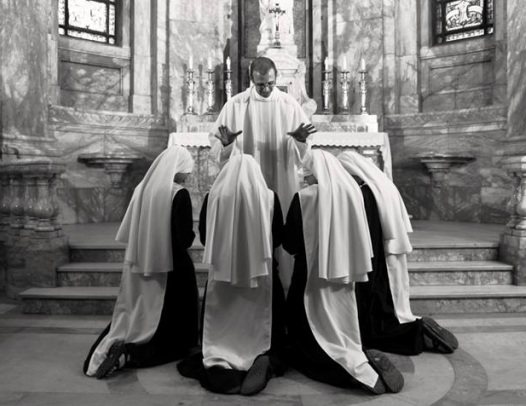 I come originally from Minnesota and don’t associate that state with any burgeoning religious institutes. However, there is a young community in New Ulm that is attracting young vocations called the Handmaids of the Heart of Jesus (Ancillae Cordis Jesu). They were were founded in 2007 and do various apostolic works in parishes to help people grow in their faith. This was the first religious order to be established within the diocese of New Ulm and to have its Motherhouse within the diocese. Articles about their life and beginnings appeared in The Journal of New Ulm and the Winsted Herald Journal a couple of years ago.
I come originally from Minnesota and don’t associate that state with any burgeoning religious institutes. However, there is a young community in New Ulm that is attracting young vocations called the Handmaids of the Heart of Jesus (Ancillae Cordis Jesu). They were were founded in 2007 and do various apostolic works in parishes to help people grow in their faith. This was the first religious order to be established within the diocese of New Ulm and to have its Motherhouse within the diocese. Articles about their life and beginnings appeared in The Journal of New Ulm and the Winsted Herald Journal a couple of years ago.
They are called Handmaids of the Heart of Jesus because “we live in imitation of our Lady as handmaid,” said Mother Mary Clare. Mother Mary Clare originally joined the Franciscan Sisters of the Renewal but felt called to return to Minnesota.
The work of the New Evangelization is vast and the Handmaids of the Heart of Jesus are prepared to go wherever the Lord calls them be it catechesis/faith formation, youth ministry, family life/marriage preparation, liturgy coordination, liturgical music, sacristy work, domestic care of churches and rectories, visitation of the sick and elderly, and education in Catholic schools. Who they are is more important than what they do. But what they do is to further the Kingdom of God as His handmaids.
The next “Come & See” date for young women between the ages of 18 and 30 is April 12-14, 2013. Contact Sr. Regina Marie at handmaids1@gmail.com with any questions.
And isn’t their homepage picture absolutely beautiful?
Parish Visitors Foundress Canonization Underway!
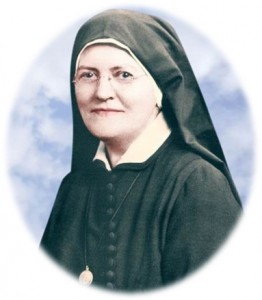 Mother Mary Teresa Tallon, foundress of the Parish Visitors of Mary Immaculate, is on her way to sainthood we hope! Cardinal Timothy Dolan has approved the process opening the way for her canonization. Sr. Maria Catherine, PVMI, Vice-Postulator for the cause, said that she hopes that the process which is now very public will allow “others to know her as we know her.”
Mother Mary Teresa Tallon, foundress of the Parish Visitors of Mary Immaculate, is on her way to sainthood we hope! Cardinal Timothy Dolan has approved the process opening the way for her canonization. Sr. Maria Catherine, PVMI, Vice-Postulator for the cause, said that she hopes that the process which is now very public will allow “others to know her as we know her.”
Holiness of life is “heroic virtue practiced consistently” in words and by example. Mother had two goals: 1) the holiness of the sisters and herself and 2) leading all souls to that holiness of life which is characterized by love for God and zeal for souls.
Cardinal Timothy Dolan of New York said that she was “way ahead of her time” when it came to evangelization. It was not a program to be administered. It was personal, one-on-one. The Parish Visitors apostolate is to go door-to-door in search of the lost sheep. They lead children and adults to faith in Jesus Christ. They are “missionaries who walk with Mary in the footsteps of the Good Shepherd.”
A typical conversation begins, “Has anyone in this household ever been baptized Catholic?” This simple question has begun the process of re-evangelizing hundreds of thousands of those who have strayed from Jesus. The Sisters strive to draw each person into closer union with Him.
One sister who knew Mother Tallon personally said: “Kindness! Mother had such love of souls and compassion….’You are spiritual mothers….Make every soul count.'”
The Parish Visitors, said Mother Tallon, “speak to the people face to face and heart to heart.”

